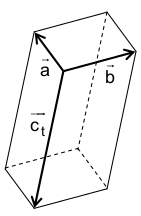The cuboid¶
Problem
The vectors
generate a geometric body for every \(t\) with \(t\in\mathbb{R}\backslash\{0\}\). The figure below illustrates this for an example of \(t\).
Prove that the generated body is always a cuboid.
Determine the values of \(t\) leading to a cuboid with a volume of 15.

Solution of part a
The generated body is a cuboid if and only if the vectors \(\vec{a}\), \(\vec{b}\) and \(\vec{c}\) are mutually orthogonal. Therefore, we calculate all possible inner products of two vectors and verify that all of them vanish.
The fact that every inner product vanishes proves that the generated body is a cuboid for any value of \(t\). The inner products can also be calculated with Sage:
Solution of part b
The volume of a cuboid can be calculated with the scalar triple product:
Together with the condition that the cuboid’s volume should be equal to 15, we obtain
which can be rewritten as
We obtain two possible solutions for \(t\). In one case, the vector \(c\) points towards the upper half-space while in the other case it points towards the lower half-space.
This result can be verified with the help of Sage. In particular, the evaluation of the triple product is significantly simplified.
